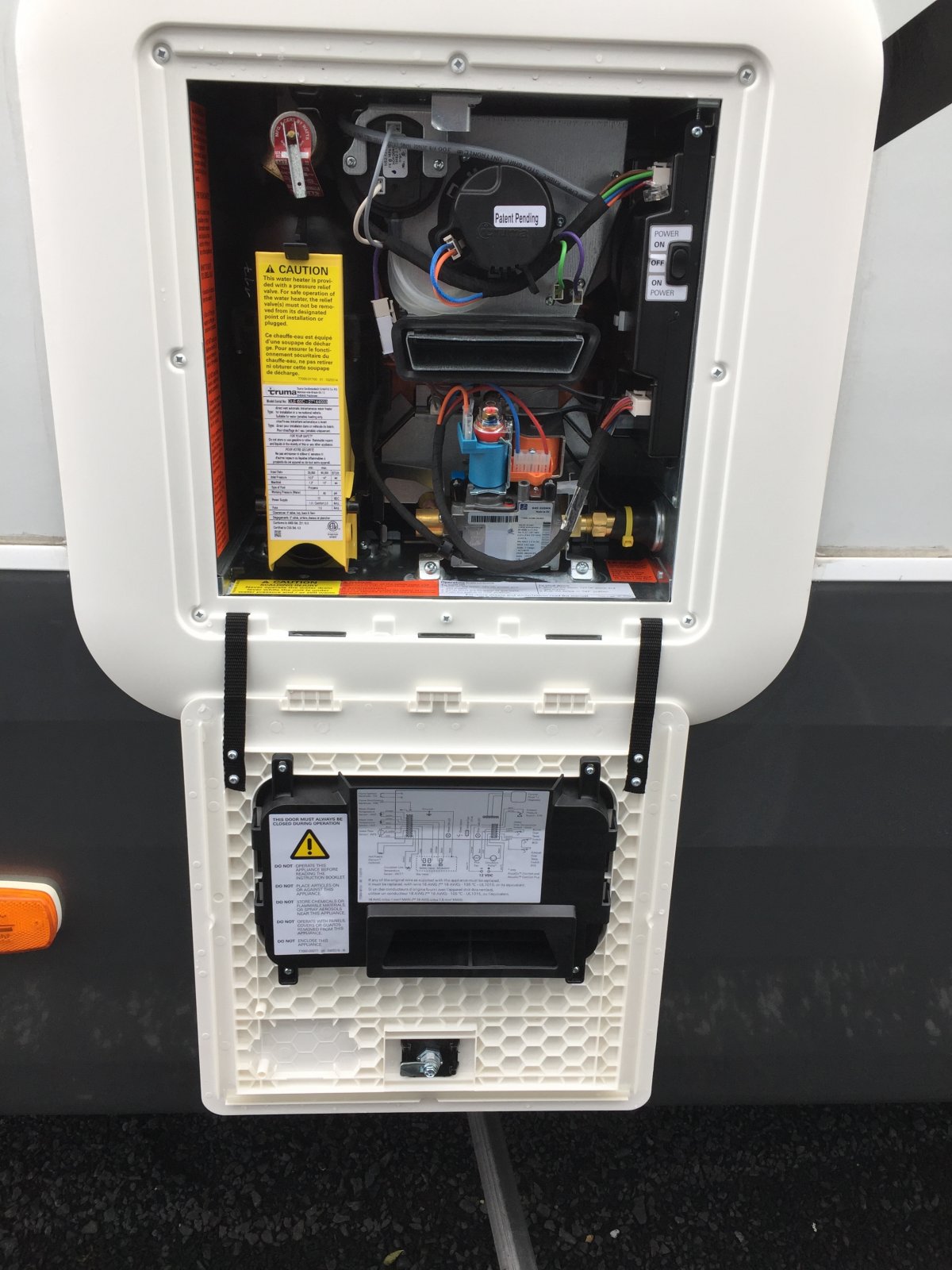Most modern RV water heaters (WH) operate in either Electric or Liquid Propane (LP) Gas mode.
In entry level RVs though, the water heater may only operate in LP gas mode.
Water heaters in other motorhomes might operate by a third heating method called Motoraid (see more below), which uses waste heat from the motorhome engine to heat the water as you drive.
Finally, some high-end RVs may have an entirely different system in which the water heater is part of a diesel and electric central heating system, typically either the Aquahot or Hydrohot brand names.

Standard RV Water Heater Basics
The standard RV water heater sizes are 6 gallon or 10 gallon—much smaller than a residential heater.
If you’re new to RVing, you may find that you’re not be able to enjoy quite as long a hot shower as at home. A few models are advertised as being 16-gallon heaters, but these are actually 10-gallon heaters that superheat the water and then mix cold water at the outlet, making them roughly equivalent to having a 16-gallon heater at the usual 140 degrees.
There will be separate On/Off switches for the Electric and LP Gas Modes. The RV water heater can be operated in either mode or both can be used to speed up the heating process.
Both are controlled by a thermostat, so the heater only runs as needed.
In LP gas mode, a heater control circuit board insures safe operation, so 12v power is needed for it to operate.
Most water heaters have separate thermostats for Electric and LP Gas modes and the two modes are pretty much independent of each other.
If one doesn’t work for some reason, usually the other will still be functional.
The standard thermostats are fixed temperature, typically 140 degrees in recent models, and you can’t adjust them.
However, there may be adjustable replacement thermostats available for some brands & models.
RV Water Heater: Electric Mode
An RV water heater in Electric Mode can be used whenever you have 120v shore or generator power available.
It requires a fairly substantial amount of electricity, about 12 amps (1400 watts), so you may not want to utilize it if power is limited, or if you want to run other high-power appliances (like an air conditioner or microwave oven) at the same time.
This is primarily a concern in RVs that have only 30A shore power wiring, or any time the RV is plugged into an outlet that has 30A or less available.
You can switch it off temporarily (the water will stay hot for some time) or change over to LP Gas mode.
When you switch on the Electric mode on your RV water heater, the Electric Mode thermostat controls whether 120v power flows to the electric heater element or not.
The heater element cycles on & off as needed, heating the water, just like your home water heater. There is no need to turn the heater off when not in use.
RV Water Heater: LP Gas Mode
The most basic model gas RV water heater has a pilot light which must be lit manually with a match or sparking device.
There is a manual valve that must be set to the “Pilot” position to light the pilot and then you move the valve to a Run position for continued operation.
Once the pilot light is lit and the heater control circuit board detects a flame at the flame sensor, the gas mode thermostat starts and stops the flow of LP gas to the burner, where it is ignited by the pilot flame.
There is no need to relight the pilot each time more hot water is needed.
If the pilot goes out, no flame is detected and no gas is allowed to flow, preventing any danger from leaking LP gas. When you no longer need to have hot water available, turn the Pilot Control switch to Off and the heater shuts down.
Most modern RV water heaters are the DSI (Direct Spark Ignition) type, which has no pilot light. When you switch on the water heater in LP Gas mode, the gas mode thermostat will call for it to be heated as needed.
When heating is called for, the heater control circuit board opens the gas valve and activates the igniter, making a spark at the front of the heater’s gas burner tube, and (hopefully) igniting the flame.
At the same time, the control board starts sensing for a flame (the igniter doubles as a flame sensor). When the burner flame is sensed, the ignition sequence is complete.
If no flame is detected after a preset time (about 15 seconds), the gas valve is closed, the igniter is turned off, and the system “locks out,” meaning it won’t allow another attempt at restarting until the system is reset by turning it off and on again.
Usually a red indicator light will show at the LP Gas Mode switch if the heater fails to light when needed.
While you can run a DSI RV water heater in LP Gas Mode while driving, this is generally not necessary since it heats up within 20-30 minutes after it is turned on anyway.
A Manual Pilot type of water heater usually does not work while driving—the wind blows the pilot light out. Few RVers leave their water heater on while traveling—it’s just a waste of fuel.

Truma Hot Water Heater. Photo via iRV2 Forums
MotorAid
The MotorAid system is conceptually quite simple.
Water from the motorhome’s engine cooling system is circulated through tubes embedded in the water heater. Whenever the engine is at its normal operating temperature, the water in the tank is being heated by the waste heat from the engine.
This provides heated water as well as assisting in cooling the engine.
RV Water Heater Maintenance
Your RV water heater requires very little care in normal use.
The Electric Mode is essentially maintenance-free, and the LP Gas mode needs only an annual cleaning of the burner tube to remove rust flakes, spider webs, etc.
A vacuum cleaner nozzle on the tube is usually sufficient. However, when you store the RV for long periods you should drain the tank (see your water heater’s owners manual) and, if sub-freezing weather is expected, winterize the associated water lines.
The RV’s heater plumbing usually has a bypass valve to assist in winterizing.
The heater bypass and winterizing procedures are part of the general RV maintenance information and not covered in the WH manual.
Endless Hot Water Heaters
Endless hot water heaters that run on your RV’s fuel supply are rapidly growing in popularity as the vendor landscape changes and the demand increases. Units from AquaHot, Truma, & Girard offer an endless supply of hot water, either through a tankless or hybrid solution.
As long as you have water and fuel (Gasoline or Diesel), you can have hot water. These types of water heaters are proving to be reliable, and are definitely the future for hot water solutions in today’s modern RVs.
Many of these require an annual maintenance procedure. Fuel nozzles need to be replaced, burner drums cleaned, and heating fluid changed. Failure to keep these maintained will result in poor or failed performance and cold showers.
Keep track of all your water heater maintenance, regardless of which type you use, with an online tool such as Maintain My RV. Not only can you keep all your maintenance records and documents in one place, you’ll receive timely reminders via email when maintenance is due, and potentially avoid a costly repair due to lack of maintenance.
Whether you have a small camper or large class A motorhome, Maintain My RV can keep track of it all. Keeping accurate maintenance records also increases your resale value, should you ever decide to do so.
RELATED ARTICLES:
read more: How to skirt your RV for the winter
read more 3 ways to keep warm when rving in winter
LEAVE YOUR COMMENTS BELOW
Looking for a place to stay in SW Missouri? Come on by. Blue Skys RV Park has both short term and long term parking. We are a no frills, affordable, family friendly place to stay. Free Wifi and a laundromat. Whether you are looking for overnight, weekly, or long term, Blue Skys RV Park is the place to be. The owners will go above and beyond to make your stay a pleasant one. Check us out: https://blueskysrvpark.com

